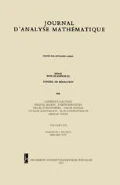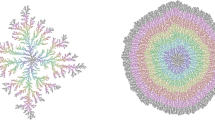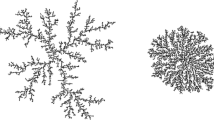Abstract
We study the scaling limits of three different aggregation models on ℤd: internal DLA, in which particles perform random walks until reaching an unoccupied site; the rotor-router model, in which particles perform deterministic analogues of random walks; and the divisible sandpile, in which each site distributes its excess mass equally among its neighbors. As the lattice spacing tends to zero, all three models are found to have the same scaling limit, which we describe as the solution to a certain PDE free boundary problem in ℝd. In particular, internal DLA has a deterministic scaling limit. We find that the scaling limits are quadrature domains, which have arisen independently in many fields such as potential theory and fluid dynamics. Our results apply both to the case of multiple point sources and to the Diaconis-Fulton smash sum of domains.
Similar content being viewed by others
References
D. Aharonov and H. S. Shapiro, Domains on which analytic functions satisfy quadrature identities, J. Analyse Math. 30 (1976), 39–73.
N. Alon and J. H. Spencer, The Probabilistic Method, John Wiley & Sons Inc., New York, 1992.
S. Axler, P. Bourdon and W. Ramey, Harmonic Function Theory, 2nd ed., Springer, Berlin, 2001.
L. A. Caffarelli, The obstacle problem revisited, J. Fourier Anal. Appl. 4 (1998), 383–402.
L. A. Caffarelli, L. Karp and H. Shahgholian, Regularity of a free boundary problem with application to the Pompeiu problem, Ann. of Math. (2) 151 (2000), 269–292.
D. Crowdy, Quadrature domains and fluid dynamics, in Quadrature Domains and Their Applications, Oper. Theory Adv. Appl. 156 (2005), 113–129.
P. Diaconis and W. Fulton, A growth model, a game, an algebra, Lagrange inversion, and characteristic classes, Rend. Sem. Mat. Univ. Pol. Torino 49 (1991), 95–119.
J. L. Doob, Classical Potential Theory and Its Probabilistic Counterpart, Springer, Berlin, 1984.
L. C. Evans, Partial Differential Equations, Amer. Math. Soc., Providence, RI, 1998.
A. Friedman, Variational Principles and Free-Boundary Problems, John Wiley & Sons Inc., New York, 1982.
Y. Fukai and K. Uchiyama, Potential kernel for two-dimensional random walk, Ann. Probab. 24 (1996), 1979–1992.
J. Gravner and J. Quastel, Internal DLA and the Stefan problem, Ann. Probab. 28 (2000), 1528–1562.
B. Gustafsson, Quadrature Identities and the Schottky double, Acta Appl. Math. 1 (1983), 209–240.
B. Gustafsson, Singular and special points on quadrature domains from an algebraic geometric point of view, J. Analyse Math. 51 (1988), 91–117.
B. Gustafsson and M. Sakai, Properties of some balayage operators with applications to quadrature domains and moving boundary problems, Nonlinear Anal. 22 (1994), 1221–1245.
B. Gustafsson and H. S. Shapiro, What is a quadrature domain? in Quadrature Domains and Their Applications, Birkhäuser, Basel, 2005, pp. 1–25.
L. Karp and A. S. Margulis, Newtonian potential theory for unbounded sources and applications to free boundary problems, J. Analyse Math. 70 (1996), 1–63.
L. Karp and H. Shahgholian, Regularity of a free boundary problem, J. Geom. Anal. 9 (1999), 653–669.
G. Lawler, Intersections of Random Walks, Birkhäuser, Basel, 1996.
G. Lawler, M. Bramson and D. Griffeath, Internal diffusion limited aggregation, Ann. Probab. 20 (1992), 2117–2140.
L. Levine and Y. Peres, Strong spherical asymptotics for rotor-router aggregation and the divisible sandpile, Potential Anal. 30 (2009), 1–27. http://arxiv.org/abs/0704.0688.
E. H. Lieb and M. Loss, Analysis, 2nd ed., Amer. Math. Soc., Providence, RI, 2001.
T. Lindvall, Lectures on the Coupling Method, John Wiley & Sons Inc., New York, 1992.
V. B. Priezzhev, D. Dhar, A. Dhar, and S. Krishnamurthy, Eulerian walkers as a model of self-organised criticality, Phys. Rev. Lett. 77 (1996), 5079–5082.
S. Richardson, Hele-Shaw flows with a free boundary produced by the injection of fluid into a narrow channel, J. Fluid Mech. 56 (1972), 609–618.
M. Sakai, Quadrature Domains, Lecture Notes in Math. 934, Springer, Berlin, 1982.
M. Sakai, Solutions to the obstacle problem as Green potentials, J. Analyse Math. 44 (1984/85), 97–116.
H. Shahgholian, On quadrature domains and the Schwarz potential, J. Math. Anal. Appl. 171 (1992), 61–78.
H. S. Shapiro, The Schwarz Function and its Generalization to Higher Dimensions, John Wiley & Sons Inc., New York, 1992.
K. Uchiyama, Green’s functions for random walks on ℤN, Proc. London Math. Soc. 77 (1998), 215–240.
A. N. Varchenko and P. I. Etingof, Why the Boundary of a Round Drop Becomes a Curve of Order Four, Amer. Math. Soc., Providence, RI, 1992.
Author information
Authors and Affiliations
Corresponding author
Additional information
Supported by an NSF Graduate Research Fellowship, and NSF grant DMS-0605166.
Partially supported by NSF grant DMS-0605166.
Rights and permissions
About this article
Cite this article
Levine, L., Peres, Y. Scaling limits for internal aggregation models with multiple sources. JAMA 111, 151–219 (2010). https://doi.org/10.1007/s11854-010-0015-2
Received:
Published:
Issue Date:
DOI: https://doi.org/10.1007/s11854-010-0015-2




